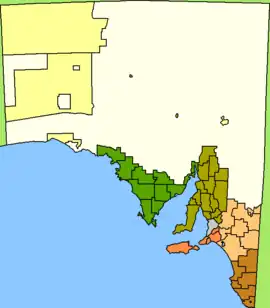| Outback Communities Authority South Australia | |||||||||||||||
|---|---|---|---|---|---|---|---|---|---|---|---|---|---|---|---|
 The extent of the Pastoral Unincorporated Area of South Australia (shown in white) | |||||||||||||||
| Population | 3,524 (2016 census)[1] | ||||||||||||||
| • Density | 0.0056444/km2 (0.0146188/sq mi) | ||||||||||||||
| Established | 2009 | ||||||||||||||
| Area | 624,339.0 km2 (241,058.6 sq mi) | ||||||||||||||
| Mayor | Cecilia Woolford[2] | ||||||||||||||
| Council seat | Port Augusta Andamooka | ||||||||||||||
| Region | Far North[3] Eyre and Western[4] | ||||||||||||||
| State electorate(s) | Giles, Stuart, Flinders[5][6][7] | ||||||||||||||
| Federal division(s) | Grey[8] | ||||||||||||||
 | |||||||||||||||
| |||||||||||||||
The Outback Communities Authority (OCA) is a statutory authority in South Australia (SA) created under the Outback Communities (Administration and Management) Act 2009.[9] It has been established to "manage the provision of public services and facilities to outback communities" which are widely dispersed across the Pastoral Unincorporated Area which covers almost 60% of South Australia's land area.[10] The authority has its seat at both Port Augusta which is located outside the unincorporated area and at Andamooka. The authority serves an area of 624,339 square kilometres (241,059 square miles),[11] slightly smaller than France. The area has a population of 3,750, of whom 639 are Indigenous Australians, and includes several large pastoral leases and mining operations.[12]
The authority's area of responsibility does not include Aboriginal Local Government Areas, the largest of which are Anangu Pitjantjatjara Yankunytjatjara in the northwest of SA and Maralinga Tjarutja in the west of SA.
History
Wangkangurru (also known as Arabana/Wangkangurru, Wangganguru, Wanggangurru, Wongkangurru) is an Australian Aboriginal language spoken on Wangkangurru country. It is closely related to Arabana language of South Australia. The Wangkangurru language region was traditionally in the South Australian-Queensland border region taking in Birdsville and extending south towards Innamincka and Lake Eyre, including the local government areas of the Shire of Diamantina as well as the Outback Communities Authority of South Australia.[13]
Yawarrawarrka (also known as Yawarawarka, Yawarawarga, Yawarawarka, Jauraworka, Jawarawarka) is an Australian Aboriginal language of Far Western Queensland. The traditional language region includes the local government area of the Shire of Diamantina extending into the Outback Communities Authority of South Australia towards Innamincka.[14]
Outback Areas Community Development Trust
The Outback Communities (Administration and Management) Act 2009 established the Outback Communities Authority as the legal successor to the Outback Areas Community Development Trust[9] which had previously been established in 1978 under the Outback Areas Community Development Trust Act 1978.[15]
Organisational structure
The authority consists of a board of seven members of which four must be residents of client communities. The board oversees a small team of support staff led by a general manager. As of 2012, support staff consisted of six persons employed full-time with one additional person employed part-time.[16]
Client communities
As of 2014, the authority provided services to the following communities: Andamooka, Beltana, Blinman, Border Village, Cockburn, Coorabie, Copley, Fowlers Bay, Glendambo, Innamincka, Iron Knob, Kingoonya, Leigh Creek, Lyndhurst, Marla, Mannahill, Marree, Oodnadatta, Parachilna, Penong, Pimba, William Creek, Woomera and Yunta.[17]
Surrounding LGAs
Because of the size of the Pastoral Unincorporated Area of South Australia, the authority provides services in an area bounded by a large number of local government areas (LGAs), 29 in total, both in South Australia and in the adjoining jurisdictions of New South Wales, the Northern Territory, Queensland and Western Australia. Its service area also completely surrounds the Municipal Council of Roxby Downs and the District Council of Coober Pedy. The following LGAs, which border the unincorporated area, total 27 with 17 being in South Australia:
Citations and references
Citations
- ↑ Australian Bureau of Statistics (27 June 2017). "Unincorporated SA". 2016 Census QuickStats. Retrieved 10 April 2018.
- ↑ "OCA members". Government of South Australia. Retrieved 12 October 2014.
- ↑ "Far North SA Government Region" (PDF). Department of Planning, Transport and Infrastructure. Retrieved 10 October 2014.
- ↑ "Eyre Western SA Government region" (PDF). The Government of South Australia. Retrieved 10 October 2014.
- ↑ "Giles, 2014 State election boundaries". ELECTORAL COMMISSION SA. Retrieved 17 October 2014.
- ↑ "Flinders, 2014 State election boundaries". ELECTORAL COMMISSION SA. Retrieved 17 October 2014.
- ↑ "Stuart, 2014 State election boundaries". ELECTORAL COMMISSION SA. Retrieved 17 October 2014.
- ↑ "Federal electoral division of Grey, boundary gazetted 16 December 2011" (PDF). Australian Electoral Commission. Retrieved 20 August 2015.
- 1 2 "Outback Communities (Administration and Management) Act 2009". Attorney-General's Department, Government of South Australia. Retrieved 10 October 2014.
- ↑ OCA, 2013, page 3
- ↑ http://www.abs.gov.au/AUSSTATS/abs@.nsf/Latestproducts/LGA19399Environment/Energy12002-2006?opendocument&tabname=Summary&prodno=LGA19399&issue=2002-2006%5B%5D
- ↑ Census 2006
- ↑
 This Wikipedia article incorporates CC-BY-4.0 licensed text from: "Wangkangurru". Queensland Aboriginal and Torres Strait Islander languages map. State Library of Queensland. Retrieved 23 January 2020.
This Wikipedia article incorporates CC-BY-4.0 licensed text from: "Wangkangurru". Queensland Aboriginal and Torres Strait Islander languages map. State Library of Queensland. Retrieved 23 January 2020.
- ↑
 This Wikipedia article incorporates CC-BY-4.0 licensed text from: "Yawarrawarrka". Queensland Aboriginal and Torres Strait Islander languages map. State Library of Queensland. Retrieved 30 January 2020.
This Wikipedia article incorporates CC-BY-4.0 licensed text from: "Yawarrawarrka". Queensland Aboriginal and Torres Strait Islander languages map. State Library of Queensland. Retrieved 30 January 2020.
- ↑ "Outback Areas Community Development Trust Act 1978" (PDF). Attorney-General's Department, Government of South Australia. Retrieved 28 February 2016.
- ↑ OCA, 2013, pages 5-7
- ↑ "Welcome to the Outback Communities Authority". Outback Communities Authority. Archived from the original on 14 April 2019. Retrieved 26 May 2019.
References
- Outback Communities Authority (OCA) Annual Report 2011 - 12 (PDF). Government of South Australia. 2013. Retrieved 11 October 2014.